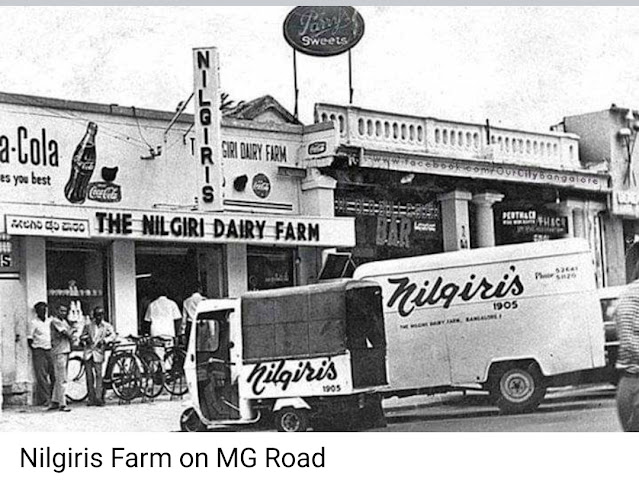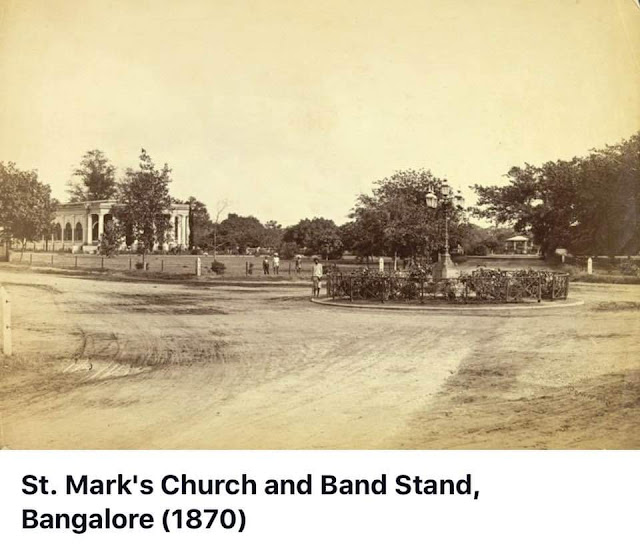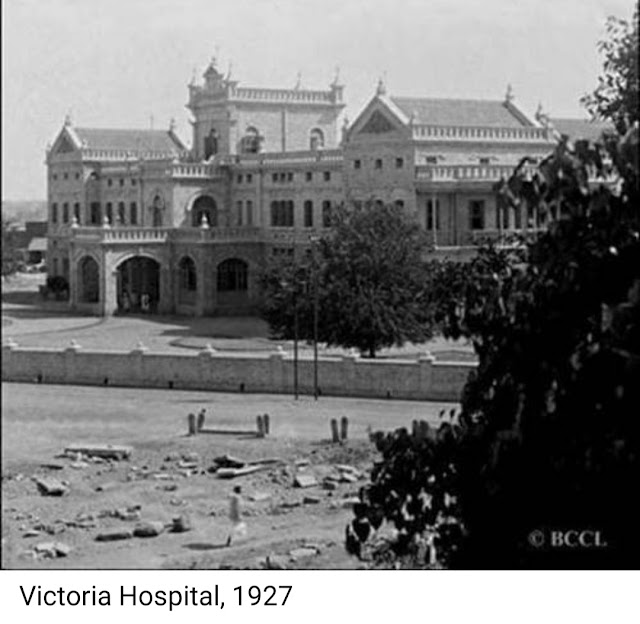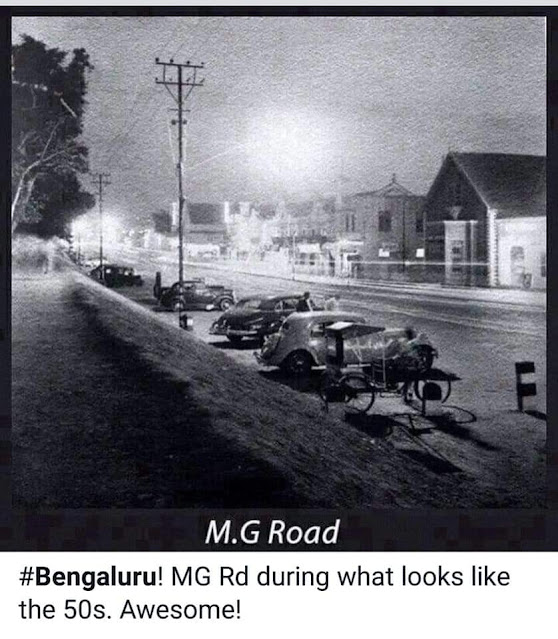Bengaluru that was built by Kempe Gowda...
1. When Kempegowda presented blue print for constructing Bengaluru city to the Vijayanagara King impressed with the vision & planning, the king not only approved it, but also gave 50000 gold coins(varahas) & six nearby areas of Bengaluru to be included under the new city.
🔱🔱🔱🔱🔱🔱🔱
2. Kempegowda had studied 8 years in a Gurukula, in Hesaraghatta before taking the reigns of Yelahanka ruled by his ancestors for decades.
Vijayanagar Kings advised Kempegowda to ensure the new city of Bengaluru will be a commercial &
dharmic Centre & self sufficient in water requirement.
⚛⚛⚛⚛⚛⚛⚛⚛
3. Bhoomi Puja of Bengaluru was done in an area between Domluru & Yelahanka.
Havana & Yagna was Conducted by the Gurukula teachers where Kempegowda had studied.
Massive Smoke and Vedaghosha had filled the air due to Vedic rituals.
♨♨♨♨♨♨
4. East-West line became Chikkapete (retail market),
North-South line became Doddapete
(wholesale market-current Avenue road).
Akki, Ragi, Arale & Taragu petes for grocery market,
Ganigara pete for oil,
Uppara pete for salt,
Kumbara pete for pottery
Tigalara pete for flower business,
Nagarth pete for gold/silver biz,
Bale pete for bangles and chains came up.
❄❄❄❄❄❄❄❄
5. Dharmambudhi lake (bus-stand), Kempambudhi lake, Halsuru lake&
Yediyuru lake were constructed for mobilising water for drinking & washing.
6. For Irrigation requirement Kempegowda constructed
Sampangi lake(Current cricket stadium).
📕📕📕📕📕📕📕📕📕📕📕
7. Having studied in Gurukula &
being a totally dharmic king,
Kempegowda constructed Gavi Gangadhareshwara temple,
Basavanagudi’s Big bull -Nandi temple,
Doddapete’s Anjaneya temple.
🙏🙏🙏🙏🙏🙏🙏
8. Gavi Gangadhareshwara temple, in Gavipura continues to amaze people with the extraordinary knowledge of astronomy and temple architecture
it synthesises to ensure Sun rays fall on the ShivLing of Lord Shiva on
Makarasankranti every year.
🌞🌞🌞🌞🌞🌞🌞
9. For protection Kempegowda constructed forts all round Bengaluru.
Mahadwaras(main entrances) for these forts were constructed at Yelahanka,
Halasuru,
Kengeri, & Anekal.
⛩⛩⛩⛩⛩⛩⛩
10. Important aspect of Bengaluru, was the Design, implementation & interlinking of Raja Kaluves (king canals which exist even today).
When a lake was filled with rain water,
Extra water was fed into other lakes through these King canals, and
finally to outside the city.
🚣♂🚣♂🚣♂🚣♂🚣♂🚣♂🚣♂🚣♂
11. By the quirk of fate, Kempegowda who founded Bengaluru, was arrested and imprisoned at anegondi on charges of treason.
The complaints to the Vijayanagar king was given by Channapttana local chieftain. ...
At this time Vijayanagara Kingdom was getting weakened with rebellion.
🤴🤴🤴🤴🤴🤴🤴🤴🤴
12. To protect Bengaluru from evil enemies, Kempegowda’s sons constructed watch towers at Lalbagh, Halsuru, Sadashivanagara, and
chamarajapete.
It is believed Dharmaraya temples lies at equidistant from these watch towers.
🔱🔱🔱🔱🔱🔱🔱🔱🔱🔱🔱
13. Every evening from atop an elevated boulder, bugle sound(KahaLe) was blown to indicate all is well in the city.
If the the bugle sound was heard at other times, it indicated threat to the city. This place is today’s bugle rock in Basavanagudi.
🔔🔔🔔🔔🔔🔔🔔🔔
14. King Aliya Ramaraya released Kempegowda from the prison after
five years, realising Kempegowda was innocent. ... Kempegowda returned to Bengaluru on a triumphant note with people giving him a Rousing welcome reception.
His popularity had in fact increased after his arrest.
🌈🌈🌈🌈🌈🌈🌈🌈🌈🌈🌈🌈
15. Kempegowda was made to sit on a silver swing(vuyyale) &
milk abhisheka was performed on him as part of his welcome.
The place where this welcome was given to Kempegowda, was called
ಉಯ್ಯಾಲೆ ಕಾವಲು, which in due course has become Vyali Kaval.
🐘🐘🐘🐘🐘🐘🐘🐘
16. Kempegowda who was an outstanding visionary, planner, dharmic leader, and a People’s leader whom every Bengalurian must thank, accidentally died in 1569, near Magadi while returning from Kunigal.
******
ಉಡುಪಿ ಮತ್ತು ಅಲ್ಲಿನ ಹಾಗೂ ಅಲ್ಲಿಂದ ನೋಡುವ ಪ್ರೇಕ್ಷಣೀಯ ಸ್ಥಳಗಳು
Places of interest in Udupi and nearby
Udupi - Near to Dharmasthala, Subramanya,Kollur, Karkala Gommateshwara, Athur Church,Kateel lots of spiritual place hardly redious (70kms)
Udupi - St. Mary's Island -Around 15 km[
Udupi - Malpe one of the Largest fishing ports in Asia
Udupi - St Mary's Syrian Orthodox Cathedral, Brahmavar, aound 13 km
Udupi - Sri Manjunatha Swamy Temple, Dharmasthala 110 kms.
Udupi - Sri Subramanya Kshetra, Subramanya 164 kms.
Udupi - Sri Sahasralingeshwara Temple, Uppinangadi 108 kms.
Udupi - Sri Karinjeshwar Temple, Bantwal 100 kms.
Udupi - Sri Durgaparameshwari Temple, Kateel 60 kms.
Udupi - Sri Ananthapadmanabha Temple, Kudupu 69 kms.
Udupi - Sri Mangaladevi Temple, Mangalore 63 kms.
Udupi - Sri Rajarajeshwari Temple, Polali 84 kms.
Udupi - Sri Kadri Manjunatha Temple, Mangalore 63 kms.
Udupi - Sri Durgaparameshwari Temple, Bappanadu 35 kms.
Udupi - Sri Gokarnanatha Temple, Kudroli, Mangalore 60 kms.
Udupi - Maravante Beach 45 kms.
Udupi - Sri Mookambika Devi Temple, Kollur 70 kms.
Udupi - Sri Sharadamba Temple, Sringeri 90 kms.
Udupi - Thousand Pillars Basadi, Moodabidri 55 kms.
Udupi - Gomateshwara, Karkala 40 kms.
Udupi - Chaturmukha Basadi, Karkala 40 kms.
Udupi - Jog Falls 100 kms.
Udupi - Jamalabad Ghada 125 kms.
Udupi - Gomateshwara, Venoor 70 kms.
Udupi - St. Aloysius Chapel, Mangalore 61 kms.
Udupi - St. Lawrence Church, Attur, Karkala 40 kms.
*******
Facts about BENGALURU!!!
Here are some interesting facts about BENGALURU...
1. BENGALURU has the impeccable record of highest growth within a span of 20 years.
2. BENGALURU has highest number of pubs in Asia.
3. BENGALURU has highest number of cigarette smokers in India
4. BENGALURU has the highest number of software companies in India - 212,
followed by Hyderabad -108,
Pune - 97.
Hence called the Silicon Valley of India.
5. BENGALURU has 21 engineering colleges, which is highest in the world
in a given city.
BENGALURU University has 57 engineering colleges
affiliated to it, which is highest in the world.
6. BENGALURU is the only city in the world to have commercial and defense airport operating from the same strip.
7. BENGALURU has highest number of public sectors and government
organizations in India.
8. BENGALURU University has highest number of students going abroad for higher studies taking the first place from IIT-Kanpur.
9. BENGALURU has only 48% of local population (i.e.Kannadigas). Hence a true Cosmopolitan with around 25%Tamilians, 14%Teluguites, 10% Keralites, 8% Europeans, 6% a mixture of all races.
10. BENGALURU police has the reputation of being second best in India after Delhi.
11. BENGALURU has the highest density of traffic in India.
12. BENGALURU has the highest number of 2-wheelers in the world.
13. BENGALURU is considered the fashion capital of east comparable to Paris.
14. BENGALURU has produced the maximum international sportsmen in India for all sports ahead of even Mumbai & Delhi.
15. BENGALURU has produced the maximum number of scientists considered for Nobel Prize nominations.
16. BENGALURU has produced the highest number of professionals in USA almost 60% of the Indian population abroad is from BANGALORE (except Gulf).
Wow 😮. BENGALURU!
This is Outstanding... 👍...




























.jpg)





No comments:
Post a Comment